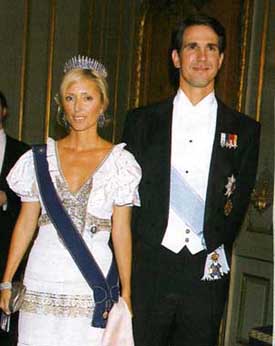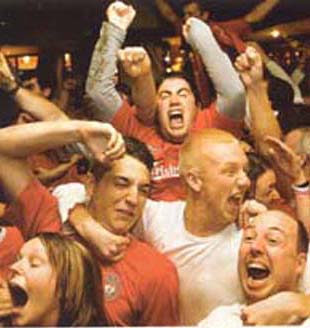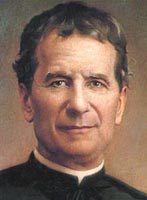 |
Formation of Children
The Smile – The Laugh – The Grimace
Marian T. Horvat
Only the other day, I had a not-so-enjoyable lunch with several friends. The dining ambience was pleasant, the food good, the company excellent. What was wrong? At the next table was a business man entertaining several clients, or perhaps other office workers. Every few minutes, he erupted with a loud raucous laugh that echoed through the room. Since he was just one table away, it was almost impossible for us to have a normal conversation. “What could he possibly be laughing at?” I couldn’t help but wonder. Nothing could be so continuously and uproariously funny.
The annoying habit to laugh without reason, as chapter VIII of the Small Manual of Civility points out, belongs to the fool, not to the civil man. Unfortunately, a certain school of behavior that burgeoned in the early Hollywood era considers it advisable to laugh at everything. It is the same optimistic school that teaches that constant joking and large toothy artificial smiles are always suitable. Everything is jolly and funny, an attitude that does not fit reality and is at variance with the life and thinking of a serious Catholic youth.
The man of past eras took care to compose himself either in private, because he was before God and His Angels; or in public, where he gave an example in society of how a Catholic should behave. For these reasons, his laugh was composed, his smile sincere and amiable, his demeanor serious but not forbidding. The American cult to spontaneity and optimism has done a lot of damage to this composure. The chapter that I translate below invites us to think seriously about taking the correct attitude.
The animal does not laugh; nor does it know why it has pleasure or why it suffers. The laugh and smile are special to man. No animal is gifted with this faculty of expressing its pleasure or sorrow by means of altering the lines of the physiognomy, because no animal has a physiognomy and no animal is capable of thinking. Laughter and the smile are the external expressions of a mental process in man, which provokes in us a sentiment of admiration, surprise or sympathy.
The smile

Affable and sincere smiles without a loss of composure - Prince and Princess Paul of Greece
|
The smile is the complement and the perfume of our relations; it awakens sympathy, completes a gesture, enfolds the features in captivating grace; it is a reflection of a man’s internal peace. The smile softens a refusal, attenuates the harshness of a remark, eases the severity of a contradiction. To smile is not only just the physical action of an upward movement of the mouth. To smile is to effuse the physiognomy with a amiable and temperate happiness that illuminates and transfigures, giving the gaze a certain composed shine of goodness and goodwill.
The smile, mirror of our interior state, is as varied as the sentiments that animate us. It is pretentious when it expresses a sentiment of pride. It is ironical in audacious and combative spirits. It is admiring in one who finds himself in the presence of beauty, good and truth. It is confused in bewildered and befuddled souls. It is amorous in compassionate and tender souls.
The smile is the flower of affability that has an affect on all our actions toward our neighbor: the greeting and farewell, the reproof and an approval, and so on. If charity is a rose, the smile is its perfume.
The smile is the weapon that wins the amity of our neighbor.
Laughter
Laughter is the sudden joyful expression of surprise caused by an external fact. Within the limits of convenience and moderation, laughter is permitted in society.It is communicative, like sadness and tears.
When it is a natural manifestation of sentiments of happiness, the laugh should conform to certain points:
- It should not burst forth raucously or immeasurably;
- It should not make the voice crack or echo with noisy sonority, like guffaws or horselaughs;
- The body should not contort or shake, as if attacked by violent stomach pains.
Only a fool laughs without reason
Immoderate or constant laughter reveals a person who is unreflective and superficial in the knowledge of persons and things. In effect, the laugh is a balanced reaction to a contrast appearing suddenly between two objects, a disharmony, a disproportion between cause and effect, the means and end, the effort and result, etc. Laughter is, therefore, a genuine and candid response to an unexpected or unforeseeable contrast.
Not everyone knows how to laugh. Cultured persons know how to laugh calmly; the fools laugh raucously. We find in the Book of Wisdom the following sentence: The fool raises his voice when he laughs.
Laughter is inconvenient when it manifests itself in the presence of dishonest or deceitful acts, a licentious word, a dubious pun or turn of phrase, or a censurable gesture. A person of good education does not give his approval by laughter or a smile to that which is contrary to good customs. On the contrary, he veils his face with a look of disapproval or repulsion, and retires from the company.
No one should laugh at the defects of others, be they physical or moral, nor should he contrive traps to make the ingenuous and simple the subject of laughter. It would be very censurable for a child to make fun of the deformities of a person, to ridicule a retarded person or a man with disabilities.
Forced laughter, that is, laughing without sufficient motive, is proper to fools and buffoons. There is also yellow laughter, made reluctantly, pretending enjoyment when one is really displeased. Such laughter is insincere and should also be avoided.
The grimace

Unseemly grimaces and riotous behavior common at football games
|
The grimace is an exterior deformation and movement of the features of the face. When some persons sing or discuss with vehemence, they make unconscious grimaces, wrinkling the forehead, goggling the eyes, contorting the nose, the mouth, and the face muscles as if they felt a violent pain. Some scholars when they write place the tip of the tongue outside the mouth and squint one eye. Certain grimaces express mockery, others signify scorn, yet others, stupefaction. Some persons are accustomed to accompany everything they say or do with grimaces of varied expressions of the features. Even more, they imitate and ridicule other persons, exaggerating their characteristics.
All this should be rigorously avoided.
The caricature is the sketched grimace. It consists of representing in cartoon fashion the salient defects or abnormalities of the features of a person, while conserving fundamental features so that the sketch is recognizable.
When referring to imaginary personages, the caricature is a comic art that ridicules defects and vices. However, when it reproduces the essential and deformed features of a known person, it constitutes a grave fault against charity, because it invites the mockery and ridicule of one’s neighbor, and robs him of the good name to which every man has the right.
It is not proper or comical to sketch caricatures of teachers or classmates in order to amuse friends.

The smile of St. John Bosco attracted young and old
|
A serene face represents a noble soul
One who has a natural, refined smile has at his disposition a powerful arm for the good. The smile of the virtuous man conquers us for the good, just as the sarcastic smile of the impious man can harm others.
St. John Bosco is presented as the most amiable of men, his smile and open gaze capable of attracting and influencing both the young and old. But there is no trace of intemperance in that smile. It is impossible to imagine this man, whose every act was turned to moving his neighbor to the love of God, bursting out in strident, raucous laughter.
St. Therese of Lisieux passed through this exile strewing her sweet smiles everywhere. She smiled to those who desired good for her and to the indifferent. She smiled because in all persons she saw Jesus, to whom she smiled continually.

Posted February 2, 2007


Related Topics of Interest
 Cleanliness and Good Hygiene Cleanliness and Good Hygiene
 The Eyes and the Gaze The Eyes and the Gaze
 Order in the Professional Life Order in the Professional Life
 Order and the Spirit of Order Order and the Spirit of Order
 How to Sit, Stand, Walk How to Sit, Stand, Walk
 The Bearing The Bearing
 Four Ways to Discern a Man's Soul by His Appearance Four Ways to Discern a Man's Soul by His Appearance
 The Eyes Are the Mirror of the Soul The Eyes Are the Mirror of the Soul
 The Face Reveals the Heart of the Man The Face Reveals the Heart of the Man
 Dressing Well - Vanity or Virtue? Dressing Well - Vanity or Virtue?

Related Works of Interest
|
|
Formation | Cultural |
Home | Books | CDs
| Search | Contact Us
| Donate

© 2002- Tradition in Action, Inc. All Rights Reserved
|
 |
|